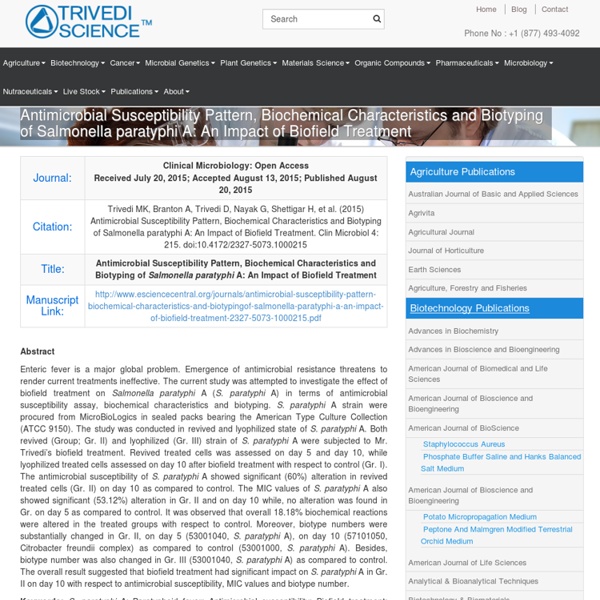An Emerging Global Opportunistic Pathogen
Abstract Stenotrophomonas maltophilia ( S. maltophilia ) is a Gram-negative bacillus, an opportunistic pathogen, particularly among nosocomial infections. Multi-drug resistant strains are associated with very high rate of morbidity and mortality in severely immunocompromised patients. Present study was designed to evaluate the effect of biofield treatment against multidrug resistant S. maltophilia . Clinical sample of S. maltophilia was collected and divided into two groups i.e. control and biofield treated which were analyzed after 10 days with respect to control. The following parameters viz. susceptibility pattern, minimum inhibitory concentration (MIC), biochemical studies and biotype number of both control and treated samples were measured by MicroScan Walk-Away® system.
Biofield Treatment: An Alternative Approach to Combat Multidrug-Resistant Susceptibility Pattern of Raoultella ornithinolytica - Trivedi Science
Abstract Raoultella ornithinolytica is belongs to the family of Enterobacteriaceae, a Gram-negative encapsulated aerobic bacillus associated with bacteremia and urinary tract infections. As biofield therapy is increasingly popular in biomedical heath care, so present study aimed to evaluate the impact of Mr. Trivedi’s biofield treatment on antimicrobial sensitivity, minimum inhibitory concentration (MIC), biochemical study, and biotype number of multidrug resistant strain of R. ornithinolytica.
Physical, Thermal and Spectroscopic Studies of Biofield Treated <i>p</i>-Chlorobenzonitrile
Physical, Thermal and Spectroscopic Studies of Biofield Treated p-Chlorobenzonitrile Science Journal of Chemistry Volume 3, Issue 6, December 2015, Pages: 84-90 Received: Sep. 19, 2015; Accepted: Sep. 30, 2015; Published: Oct. 16, 2015 DOI: 10.11648/j.sjc.20150306.11 Views 557 Downloads 25 Authors Mahendra Kumar Trivedi, Trivedi Global Inc., Henderson, USA Alice Branton, Trivedi Global Inc., Henderson, USA
Evaluation Of Biofield Treatment On Cancer Biomarkers
Abstract Increasing cancer rates particularly in the developed world are associated with related lifestyle and environmental exposures. Combined immunotherapy and targeted therapies are the main treatment approaches in advanced and recurrent cancer.
Physicochemical and Spectroscopic Characterization of Biofield Treated Triphenyl Phosphate
Physicochemical and Spectroscopic Characterization of Biofield Treated Triphenyl Phosphate American Journal of Applied Chemistry Volume 3, Issue 5, October 2015, Pages: 168-173 Received: Sep. 15, 2015; Accepted: Sep. 26, 2015; Published: Oct. 15, 2015 Views 1163 Downloads 26
Influence of Human Biofield on Klebsiella oxytoca
Abstract Klebsiella oxytoca (K. oxytoca) is a Gram-negative microbe generally associated with community and hospitalacquired infections. Due to its clinical significance, we evaluated the effect of biofield treatment on phenotype and biotype characteristics of K. oxytoca (ATCC 43165). The study was performed into three groups i.e. C (control), T1 (treatment, revived); and T2 (treatment, lyophilized).
Biofield Treatment on Quality of Beef Extract and Meat Infusion Powder
The present research work investigated the influence of bio-field treatment on two common flavoring agents used in food industries namely beef extract powder (BEP) and meat infusion powder (MIP). The treated powders were characterized by Fourier transform infrared spectroscopy (FT-IR), X-ray diffraction (XRD), particle size analysis, surface area analysis, differential scanning calorimetry (DSC), and thermogravimetric analysis (TGA). The FT-IR results showed disappearance of triglycerides peaks in both the treated powders as compared to control. XRD results corroborated the amorphous nature of both control and treated samples. The BEP showed enhanced average particle size (d50) and d99 (size exhibited by 99% of powder particles) by 5.7% and 16.1%, respectively as compared to control.
Effect of Biofield Energy Treatment on Streptococcus group B: A Postpartum Pathogen - Trivedi Science
Abstract: Streptococcus agalactiae group B (S. agalactiae gr. B) is widespread in nature mainly causes bacterial septicemia and neonatal meningitis. The current study was attempted to investigate the effect of biofield treatment on S. agalactiae gr. B with respect of antimicrobial sensitivity, biochemical reactions and bio typing. S. agalactiae gr.



